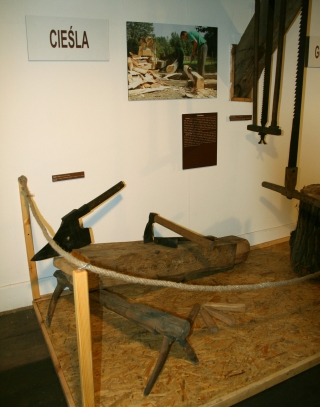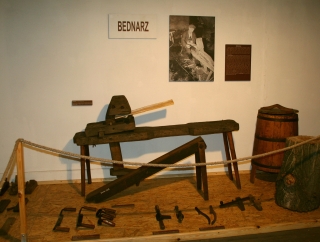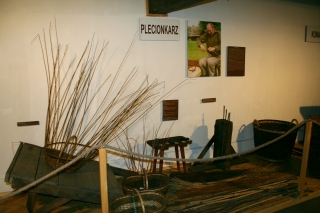In 1994, the Ministry of Culture and Art of Poland initiated the Program of protection of dying professions and handicraft skills entitled: “Dying Professions”. The program aimed at recognizing the traditional artistic handicrafts of the gradually falling into oblivion occupations as an important component of national culture. In the frameworks of the program the Museum “Upper Silesia Ethnographic Park in Chorzów” conducted survey research and collected rich photographic and video-recorded documentation, which resulted in the discussed exhibition arranged in a manor granary from Śmiłowice dating back on the 18th century. The exhibition presents a wide selection of of tools, raw materials and ready-made products divided into 14 stalls presenting occupations such as carpenter, roofer, woodworker, wheeler, barrel maker, gravedigger, cobbler, harness maker, weaver, rope maker, tailor, braider, blacksmith and potter. The first edition of the exhibition took place in 1997 (in the artwork by late Krystyna Jędrzejowska – Nowak) – the present arrangement was made in 2007. The exhibits come from the collections of the Museum “Upper Silesia Ethnographic Park in Chorzów”, the Upper Silesian Museum in Bytom, the Museum in Rybnik and the Museum of the Opole Countryside in Opole. The exhibition is accompanied by a catalog entitled: Tradycyjne rzemiosło ludowe „Ginące zawody”, Chorzów 2005.
Woodworking

Woodworking crafts have beautiful traditions in Upper Silesia as evidenced by the high-quality craftsmanship of numerous historic wooden churches erected by local builders. Among the woodworkers there were the masters specializing in the construction of such complex facilities as water mills, windmills, fulling mills. Unlike other professions, woodworkers did not have permanent workshops, but only the necessary set of tools – an ax, a hatchet, a chisel, a drill, a saw, a meter, and a spirit level.
Shingling
The most popular way to cover roofs in rural buildings in the nineteenth century was to cover them with straw and shingles. Tiles and roofing paper were introduced later. The wooden shingle is a wedge-shaped small board with a nodule on one side and a crest on the other (8-10 cm wide and 60-70 cm long). It is stacked on a full roof cladding. Larch shingles used to cover churches and mansions are the most durable. The shingles, despite their high flammability, are still used because of the softness of the texture and the lightness thanks to which even a really tall roof does not overwhelm optically the building.
Carpentry
Professional carpenters deal mainly in furniture (tables, stools) and woodworks (doors, windows, floors). Having a permanent job, they adapted their products to the tastes and orders of the locals. The carpentry workshop was usually located in a shed. A lathe and a circular saw were placed in the center part of the workshop. At one of the walls there were usually set a carpentry table. Among carpenter’s tools we can find saws, chisels, jack-planes and screw clamps.
Barrel making

The workshop of a barrel maker was usually located in a room of a house or in a shed. The traditional permanent equipment used by a barrel maker consisted of a tresle for embracing staves and a tool cupboard. Traditional hand tools commonly used for woodworking were so-called “wątornik” for cutting a groove inside a vessel for installing the bottom, a wooden compass, an ax, a telescope and a winch. Different types of wood were used. Churns were made of spruce wood, and barrels of oak. Linden and poplar wood were also used for barrel making, however they were considered less durable. Good material should not have knots, and have the rings that run evenly. The best raw material is wood cut in winter because it does not contain too much resin. The wood was dried for at least two years. Cooperage that is a rim made of a metal tape was used for tightening barrels. The production process started with the splitting of the wooden block into pieces of splint timber. After drying, the barrel maker carved staves on the tresle. At the end of the process he applied hoops, and the gaps between staves were sealed with the leaves of the herb. Then he heated the interior and tighten the whole barrel by the means of a winch.
Braiding



